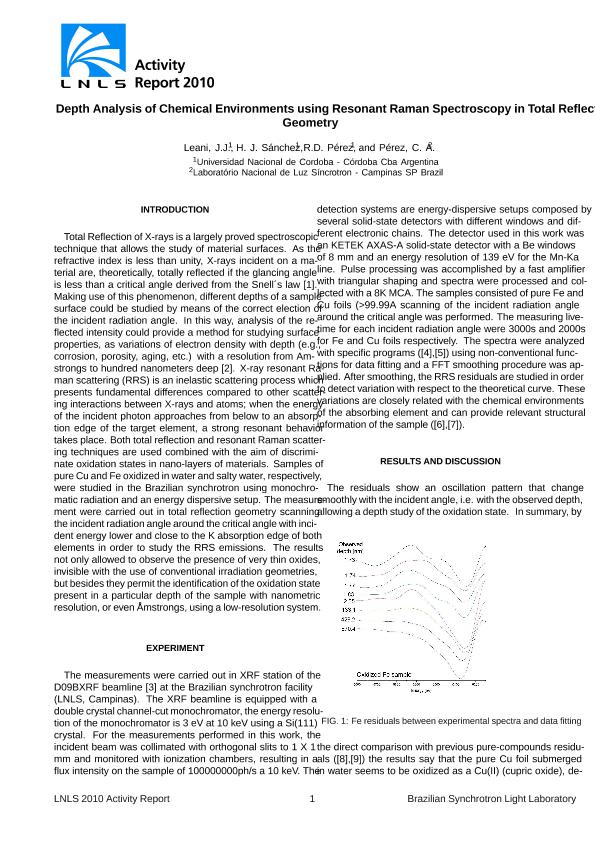Mostrar el registro sencillo del ítem
dc.contributor.author
Leani, Juan Jose

dc.contributor.author
Sánchez, H. J.
dc.contributor.author
Pérez, R. D.
dc.contributor.author
Pérez, C. A.
dc.date.available
2021-05-07T18:28:29Z
dc.date.issued
2010-06
dc.identifier.citation
Leani, Juan Jose; Sánchez, H. J.; Pérez, R. D.; Pérez, C. A.; Depth Analysis of Chemical Environments using Resonant Raman Spectroscopy in Total Reflection Geometry; Brazilian Association for Synchrotron Light Technology; Activity Report; 2010; 6-2010; 3-4
dc.identifier.issn
1518-0204
dc.identifier.uri
http://hdl.handle.net/11336/131690
dc.description.abstract
Total Reflection of X-rays is a largely proved spectroscopic technique that allows the study of material surfaces. As the refractive index is less than unity, X-rays incident on a material are, theoretically, totally reflected if the glancing angle is less than a critical angle derived from the Snell´s law [1]. Making use of this phenomenon, different depths of a sample surface could be studied by means of the correct election of the incident radiation angle. In this way, analysis of the re- flected intensity could provide a method for studying surface properties, as variations of electron density with depth (e.g., corrosion, porosity, aging, etc.) with a resolution from Amstrongs to hundred nanometers deep [2]. X-ray resonant Raman scattering (RRS) is an inelastic scattering process which presents fundamental differences compared to other scattering interactions between X-rays and atoms; when the energy of the incident photon approaches from below to an absorption edge of the target element, a strong resonant behavior takes place. Both total reflection and resonant Raman scattering techniques are used combined with the aim of discriminate oxidation states in nano-layers of materials. Samples of pure Cu and Fe oxidized in water and salty water, respectively, were studied in the Brazilian synchrotron using monochromatic radiation and an energy dispersive setup. The measurement were carried out in total reflection geometry scanning the incident radiation angle around the critical angle with incident energy lower and close to the K absorption edge of both elements in order to study the RRS emissions. The results not only allowed to observe the presence of very thin oxides, invisible with the use of conventional irradiation geometries, but besides they permit the identification of the oxidation state present in a particular depth of the sample with nanometric resolution, or even Åmstrongs, using a low-resolution system.
dc.format
application/pdf
dc.language.iso
eng
dc.publisher
Brazilian Association for Synchrotron Light Technology
dc.rights
info:eu-repo/semantics/openAccess
dc.rights.uri
https://creativecommons.org/licenses/by-nc-sa/2.5/ar/
dc.subject
Depth Analysis
dc.subject
Chemical Environments
dc.subject
Raman scattering
dc.subject
RRS
dc.subject.classification
Física Atómica, Molecular y Química

dc.subject.classification
Ciencias Físicas

dc.subject.classification
CIENCIAS NATURALES Y EXACTAS

dc.title
Depth Analysis of Chemical Environments using Resonant Raman Spectroscopy in Total Reflection Geometry
dc.type
info:eu-repo/semantics/article
dc.type
info:ar-repo/semantics/artículo
dc.type
info:eu-repo/semantics/publishedVersion
dc.date.updated
2021-04-28T20:13:56Z
dc.journal.volume
2010
dc.journal.pagination
3-4
dc.journal.pais
Brasil

dc.description.fil
Fil: Leani, Juan Jose. Universidad Nacional de Córdoba. Facultad de Matemática, Astronomía y Física; Argentina. Consejo Nacional de Investigaciones Científicas y Técnicas. Centro Científico Tecnológico Conicet - Córdoba; Argentina
dc.description.fil
Fil: Sánchez, H. J.. Universidad Nacional de Córdoba. Facultad de Matemática, Astronomía y Física; Argentina
dc.description.fil
Fil: Pérez, R. D.. Universidad Nacional de Córdoba. Facultad de Matemática, Astronomía y Física; Argentina
dc.description.fil
Fil: Pérez, C. A.. Laboratório Nacional de Luz Síncrotron; Brasil
dc.journal.title
Activity Report
Archivos asociados
